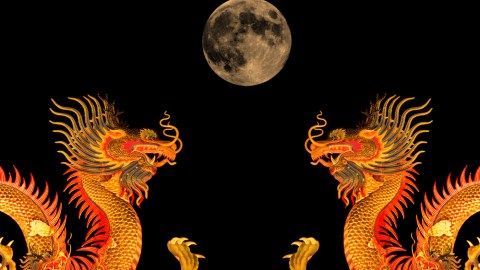China Super Moon: Here There Be Dragons

The U.S. is in a space race with China, it just doesn’t know it yet. How many Chinese taikonauts have to return from outer space before we recognize this? Ever since putting its first man into space in 2003, the Chinese space program has been on a roll. There have now been five manned space missions, including a celebrated spacewalk in 2008. Going forward, the Chinese plan to launch unmanned expeditions to Mars and Venus by the end of this decade, put a manned space station into orbit by 2020, and even establish a manned base on the moon by 2025. Yet, the U.S. seems mostly content to mothball its space shuttle program, hitchhike to the international space station on Russian rockets and let the invisible hand of Adam Smith guide the future of American space innovation. We’ve led the space race for so long – 50 years and counting – is it possible that we’ve forgotten to look in the rear view mirror?
The plan for a Chinese manned presence on the moon by 2025 is what should really catch the attention of U.S. space pundits. Space entrepreneur Robert Bigelow of Bigelow Aerospace claims that China is about to play a game of “solar system monopoly” in which it goes about a massive land grab in outer space, starting with the surface of the moon. Experts point to the potential economic value of natural resources like water and helium-3 from the moon, both of which can be used as part of nuclear reactors. There might be other minerals, as well, rather than just a bunch of worthless lunar dust. Heck, there are even purportedly plans by the Chinese to grow fruits and vegetables on the surface of the moon. By the time the Americans catch up, it will be too late – all the best resources will have been spoken for, and we may even need special landing rights to even land on the moon!
That is, if the Chinese don’t shoot our Lunar Reconnaissance Orbiter (LRO) satellites out of the sky before then.
That’s always been the secret fear of the U.S. space establishment – the presence of China in outer space might lead to the militarization of space. The Chinese already shot down one unused satellite in 2007 that triggered much global hand-wringing. Ultimately, at the end of the day, the Chinese space program is a military program, making the taikonauts the future “boots on the ground” for any initiative to colonize the moon.
These two arguments for getting to the moon – the economic resource argument and the militarization argument – are trumped by one other argument: the national pride argument. When the latest Shenzhou X mission went up to the applause of billions of people – it wasn’t Cmdr. Hadfield singing a David Bowie song the people wanted, it was a teacher-astronaut doing a live science experiment for 60 million Chinese school children. You see, each Chinese space mission fits into a longer-term goal of scientific and technological greatness. It is the hope that each successive space mission – unbounded by partisan political constraints and bureaucratic budget issues, as they are in the U.S. – will lead to global (and interstellar?) Chinese greatness. The moon will become the Chinese super moon – made possible by deep pockets, national will and renewed emphasis on science and technology as the gateway to economic greatness.
That’s why it’s so puzzling that China’s plans to establish a manned presence on the moon hasn’t created more of a sense of urgency at NASA. Remember when we looked up into the night sky and thought we could see the orbiting Russian Sputnik? That’s what’s going to happen a decade from now: we will look up at the moon and realize that the Chinese did something that we could have done decades ago, but didn’t. We will tuck our small children into bed at night, knowing that the friendly man-in-the-moon has been replaced by Chinese space dragons.
Of course, there will be those who say that viewing space from the perspective of a “race” is just the wrong mentality. In this global, interconnected world no longer haunted by a global arms race, we should be talking about cooperation – we should view the Chinese as our future partners, not as antagonists. There are others who say that going to the moon is a case of “been there, done that,” and that it’s time to move on to other things, like exploring local asteroids and sending a mission to Mars.
But this misses the bigger picture: the exploration of the moon sets into motion a whole host of other opportunities for a nation’s space program. As NASA astronaut Buzz Aldrin outlined in his latest book,Mission to Mars, there is actually quite a bit of value to the moon when it comes to planning future trips to Mars. And make no mistake about it — the Chinese are going to the moon. It’s not a question of “if,” but “when.” And even if the U.S. continues to ignore the fact that it’s in a space race with the Chinese – countries like India and Japan will not. By the time the “Asian Space Race” heats up, let’s just hope we’ve managed to pacify the Chinese dragon.
image: Chinese Dragon Statue and the Moon / Shutterstock





